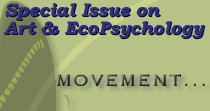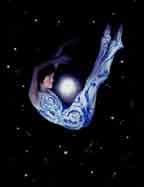

 |
 |
 |
|
Mountains
and Rivers without End
Forty
years in the making, Gary Snyder's autobiographical series of poems
follow the course of his life in an undulating flow through landscape
and time. The poetry is characterized by Snyder's legendary ability
to weave human experience into the vibrant warp of the natural world.
Anima Mundi brings the relationship between these multi-textured
strands to life through a complex interplay of elements: visual
imagery and light, sound and movement. "Streams
and rivers never stay the same." The incandescent Kathryn Roszak
introduces the evening's performance with a line from the last stanzas
of Snyder's 'Finding the Space in the Heart'. And indeed, as the
fluidity of words and music and movement unfolds, it blends into
one ever-changing image, one feeling-in-motion. Beginning
with the deep overtone chanting of a Tibetan monk, the amazing Bob
Ernst uses his deep and resonant voice to extend Snyder's poetry
with owl song and djembe calls, bamboo flute and jungle shrieks,
harmonica wails and Tibetan bells. At one point, he and all the
dancers are playing a pine cone like a thumb piano (and it works!). Enormous
images of petroglyphs, mountainsides, animal tracks in the sand,
moving highways and single pine cones serve as backdrop to his mesmerizing
voice and the primal movements of the dancers, who seem to be ethereal
emanations of the earth spirits Snyder's words evoke. Bone's portrayal
of a lizard during one scene is spell-bindingly perfect- he brings
us inside the alien world of an alert reptile, cocking his head
to and fro' before scurrying across the stage. Roszak's choreography
is superb, too, in the subtle changes of action within the ongoing
tale. Dancers intertwine with the actor in what is for the most
part a seamless flow through various landscapes and emotional tenors. The
musical score reinforces this seamless quality, blending perfectly
with the actor's expression, and bringing a beautifully balanced
interplay of natural and human sound with Castle's remarkable electronic
tonal patterns influenced by Snyder's own eastern inspirations.
Castle uses the innate music of nature and man-in-nature as the
basis for his symphony of organ, water dripping and cars moving,
violin, and saxophone. Much, but not all, of the music is based
upon Castle's fascinating work on mapping the spatial patterns between
points - the space between a lizard's footprints, running across
the sand, for example, sets the musical notes for the score. (Read
more about this in Castle's musical interview, found in the Sound
section of this issue.) Kathryn Roszak ends the piece by informing the audience that they've been in dialogue with Gary Snyder, who authorized their use of his poems, and apparently he too had been envisioning his work not only as poetry, but as performance- with dance and music, etc. I can only imagine he would be very pleased indeed with Anima Mundi's interpretation. |
